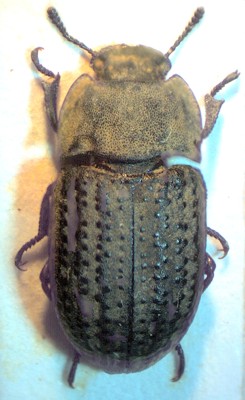Pests
Opatrum sabulosum (L.) - Darkling Beetle
Systematic position.
Class Insecta, order Coleoptera, family Tenebrionidae, genus Opatrum.Biological group.
Polyphagous pest.Morphology and biology.
Imago body 7-10 mm in length, oval, with almost parallel sides, poorly convex, black or grayish-brown. Eyes are incompletely cut by lateral head edge. Clypeus in front with a deep semicircular emargnation. Last segment of maxillary palpus is not expanded. Pronotum is transverse, coarsely punctated, with a pair of smooth eminences on its disk. Male fore tarsi are not expanded and without dense brush of ventral hairs. Elytra with irregular longitudinal rows of large tubercles; hind wings are absent. There is a shining membrane between penultimate abdominal sternites. Larva to 18 mm, flattened-cylindrical, dark gray to ocherous with dark head and prothoracic tergite. Cuticle is mat; ventrum is lighter. Ocelli are present. Mandible and clypeus bear two clavate spinules in the middle. Fore femora from inside with three and trochanters with two blunt projected chitinous tubercles. Caudal segment is not longer than wide at base, sometimes slightly shorter than wide, lighter at base, stronger pigmented at apex, widely conic from anterior third with rounded and slightly raised apex on each side bearing 16 to 24 spinules in irregular row. Female lays eggs in ground at a depth of 2-5 cm by batches of a few to 10 eggs per batch; one female can lay 100 eggs for a season. The incubatory period lasts 7-22 days depending on temperature of environment. Larvae develop 56-70 days. They pupate in ground at a depth of 3-6 cm; the stage of pupa lasts 8-15 days. Beetles winter among the vegetation residues in fields and in ground at a depth of 5-20 cm.Distribution.
Western Europe, northwestern Iran, northwestern China. In the former USSR, the species is widespread in the European part (except for the Far North), the Caucasus, South and Middle Siberia (eastward to Baikal), Kazakhstan, mountain and foothill areas of Central Asia.Ecology.
Beetles live 2-3 years. They emerge from ground right after snow thaws at the end of March or beginning of April at air temperatures 10-12°C and higher, feeding actively at temperatures 17-20°C. At temperature below 25°C they prefer dry and withered weakened plants, at temperature above 27°C they eat green plants almost exclusively. In April usually the beetles pair, and at the end of April or beginning of May oviposition begins, proceeding to the end of May - beginning of June. Pupae meet from the last third of June to the last third of August. Beetles of a new generation appear in July, emerging throughout August, forming the second wave of bugs on agricultural lands. Larvae hatched from late egg-batches pupate in August-September, remaining in cradles until spring. The Darkling Beetle avoids humid soils and habitats. Beetles and larvae eat dead vegetation residues and live plants.Economic significance.
The pest greatly damages sprouts in spring. Its harmfulness sharply increases in early warm and droughty spring. The Darkling Beetle is a eurytopic xerophile, preferring dry sites; it is most harmful in steppe zone of the former USSR. Beetles damage spring shoots of cereals, sugar beet, flax, sunflower, tobacco, cotton, pumpkin, fennel, anise, castor-oil plan, safflower, buckwheat, bean, also gnawing sown grain including corn, shoots of fruiters, sometimes shoots of grapevine. They eat round cotyledons and young leaflets of sprouts at soil surface, gnaw through small stalks of young plants at base. Larvae damage seeds, roots, underground parts of stalks of various cultures, but usually presenting no danger because of late appearance of older instars (June). Control measures are mainly agrotechnical, including optimal early sowing, application of fertilizers, control of weeds, seed dressing, optimal irrigation for tilled crops, application of poisoned baits.Reference citations:
Arnol.di L.V. & Gur.eva E.L. 1960. Coleoptera. In: Arnol.di L.V., ed. Insect pests of maize in the USSR: handbook. Moscow & Leningrad: AN SSSR, p. 115-160 (in Russian).Belyaev I.M. 1974. Pests of grain crops. Moscow: Kolos. 284 p. (in Russian).
Gussakovskii V.V. 1949. Coleoptera. In: Pavlovskii E.N. & Shtakelberg A.A., eds. Pest Animals of Middle Asia (handbook). Moscow & Leningrad: AN SSSR, p. 57-110 (in Russian).
Kabanov V.A. 1977. Biology of Opatrum sabulosum L. in forest-steppes and steppes of the European part of the USSR. Biologicheskie nauki 9 (165): 47-53 (in Russian).
Minoranskii V.A. 1973. Dependance of number and harmfulness of Opatrum sabulosum L. on hydrothermal conditions. Vestnik zoologii 5: 53-58 (in Russian).
Minoranskii V.A. 1978. Some features of biology and behavior of Opatrum sabulosum L. (Coleoptera, Tenebrionidae ) in the Northern Caucasus. Entomologicheskoe obozrenie 57(1): 37-47 (in Russian).
Minoranskii V.A. 1989. Protection of irrigated field cultures from pests. Moscow: VO Agrokhimizdat, 205 p. (in Russian).
Nurmuratov T.N., ed. 1986. Cereal protection from pests, diseases and weeds. Alma-Ata: Kainar: 268 p (in Russian).
Sakharov N.L. 1947. Harmful insects of lower Volga area. Saratov: OGIZ, 423 p. (in Russian).
Vasil'ev V.P., ed., 1974. Pests of agricultural crops and forest plantations. V. 2. Kiev: Urozhai. 606 p. (in Russian).
Znamenskii A.V. 1926. Field insect pests. Part 1. Grain cereal pests. Poltava: Poltavskaya sel.-khoz. op. st. 296 p. (in Russian).


